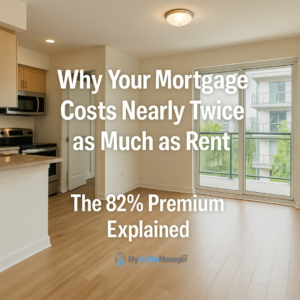For many Americans, the dream of owning a home is becoming less attainable. Recent data from housing research firm Zonda shows that mortgage payments are now, on average, 82% higher than monthly rent for a comparable two-bedroom unit. This widening gap is reshaping the housing market, influencing decisions about whether to rent or buy—and sparking new conversations about affordability and access to homeownership.
Mortgage Payments vs. Rent: A Stark Contrast
According to Zonda’s findings:
-
A monthly mortgage payment on a typical two-bedroom home is now approximately $2,161.
-
In contrast, the monthly rent for a similar unit averages around $1,186.
-
That’s a $975 premium every month for choosing to buy over rent.
This difference means renters are saving nearly $12,000 annually compared to homeowners making monthly mortgage payments. For many households, that’s not just a statistic—it’s the difference between financial flexibility and strain.
City-by-City Breakdown: Where the Gap Is Even Worse
While the national average sits at an 82% premium, some cities far exceed that:
-
Las Vegas, NV
Mortgage payments are a staggering 166% higher than rents. Housing prices soared during the pandemic, and interest rates have only magnified the disparity. -
Phoenix, AZ & Boise, ID
Both markets saw >140% mortgage premiums. These areas were hot spots for relocation and investment in recent years, pushing prices well beyond what many locals can afford. -
Austin, TX
Another pandemic-era boomtown, where monthly mortgage costs eclipse rent by more than 130%.
Meanwhile, in cities like Miami and Chicago, the gap is more moderate (around 40–50%)—but still significant, especially considering these metros already have high living costs.
Why Is Homeownership So Much More Expensive?
Several compounding factors are driving this affordability crisis:
1. Elevated Home Prices
The median price of an existing single-family home in the U.S. rose to $402,300 in Q1 2025. That’s a 5% increase year-over-year, with 83% of metro areas recording price growth. Even in a cooling market, housing prices are showing resilience.
2. High Mortgage Rates
Mortgage interest rates remain elevated, hovering around 7% or higher for many buyers. The combination of high prices and steep borrowing costs has pushed monthly mortgage payments beyond what many households can comfortably afford.
3. Limited Supply
The ongoing housing shortage—particularly for affordable single-family homes—has kept demand high and supply constrained. This imbalance continues to fuel price increases, especially in fast-growing metros.
4. Hidden Costs of Homeownership
Beyond principal and interest, homeowners must also budget for property taxes, insurance, and maintenance—costs renters typically don’t face directly. These expenses add to the total monthly burden and widen the gap between renting and owning.
What This Means for Buyers, Renters, and the Market
For Homebuyers
Many prospective buyers are choosing to delay purchasing until conditions improve. Some are stretching budgets, seeking help from family, or relocating to more affordable areas. Others are turning to alternative financing options—such as adjustable-rate mortgages or shared equity programs—to reduce monthly payments.
For Renters
Renters are benefiting from relatively stable rents compared to the explosive growth in homeownership costs. While rents are still high in many cities, they haven’t spiked at the same rate as mortgage payments. This makes renting the more affordable and flexible option for many families.
For the Housing Market
The growing cost gap is cooling demand in the homebuying sector, especially among first-time buyers. Builders and policymakers may need to pivot strategies to address affordability, including zoning reform, tax incentives for new construction, and down payment assistance programs.
Looking Ahead: Will the Gap Close?
Unfortunately, experts predict that the gap between mortgage payments and rent may persist for the foreseeable future. While some regional markets may stabilize, the combination of high interest rates and sustained demand means that owning a home will remain financially out of reach for many Americans—especially without significant policy or economic shifts.
Until then, renting is likely to remain the more accessible and cost-effective choice for millions.
Conclusion
The American dream of homeownership is facing a reality check. With mortgage payments now 82% higher than rent, families are being forced to rethink their housing choices. While homeownership still holds long-term financial and emotional value, the numbers paint a clear picture: in today’s market, renting may be the smarter move—at least for now.
Source: Scotsman Guide – Mortgage payments in the U.S. are 82% higher than rents

